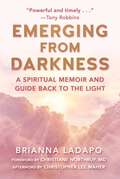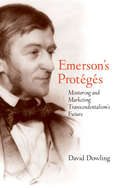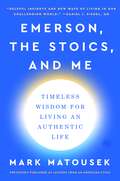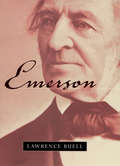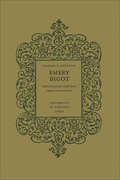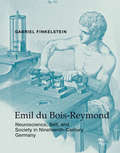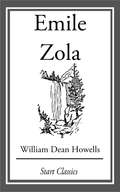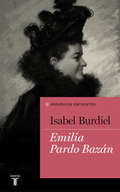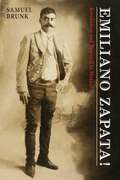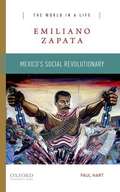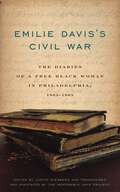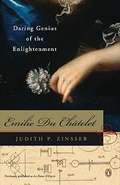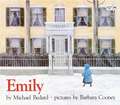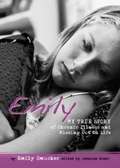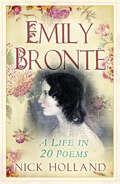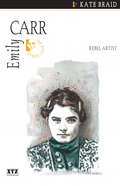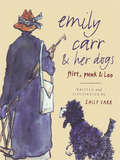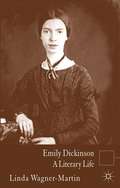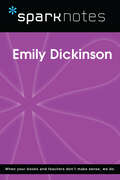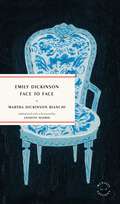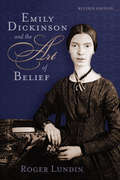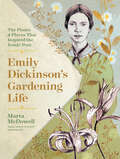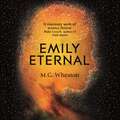- Table View
- List View
Emerging from Darkness: A Spiritual Memoir and Guide Back to the Light
by Brianna LadapoOne woman's extraordinary journey from a life of physical and emotional pain to health and wholeness This book is about the divine personal journey from the darkness into the light, and the collective journey we have undertaken as human beings, incarnated on earth at this spectacular moment of transformation, to move out of the separation consciousness that keeps us locked into patterns of conflict, suffering, and destructive behavior. The author takes us through her troubled, tumultuous childhood in a deeply religious family who believed her extraordinary intuitive gifts to be the work of the devil. As she struggled to adapt to a world in which she felt completely alien, her desire for self-preservation and acceptance led her to actively suppress these gifts. The result was a great deal of suffering, including chronic migraines that regularly put her in the hospital, severe physical illness that nearly killed her, persistent, dark visions of tragedies she could not prevent, and countless sexual traumas and abuses that seemed to define every relationship in her formative years. This led to a deep distrust and fear of others, incredible self-doubt and loathing, and ultimately, a very dark depression. Finally, an encounter with a divinely gifted healer reawakened her gifts and taught her how to truly free herself from her trauma and experience a life she loves, invulnerable to programming, fear, shame, or external influences. The author&’s experience serves both as loving encouragement for all those suffering under the current reality, and as a practical guide for reclaiming your sovereign soul, discovering your true purpose, and finding the courage to pursue it fearlessly.
Emerson's Protégés
by Prof. David DowlingIn the late 1830s, Ralph Waldo Emerson, American essayist, poet, lecturer, and leader of the Transcendentalist movement, publicly called for a radical nationwide vocational reinvention, and an idealistic group of collegians eagerly responded. Assuming the role of mentor, editor, and promoter, Emerson freely offered them his time, financial support, and anti-materialistic counsel, and profoundly shaped the careers of his young acolytes--including Henry David Thoreau, renowned journalist and women's rights advocate Margaret Fuller, and lesser-known literary figures such as Samuel Ward and reckless romantic poets Jones Very, Ellery Channing, and Charles Newcomb. Author David Dowling's history of the professional and personal relationships between Emerson and his protégés--a remarkable collaboration that alternately proved fruitful and destructive, tension-filled and liberating--is a fascinating true story of altruism, ego, influence, pettiness, genius, and the bold attempt to reshape the literary market of the mid-nineteenth century.
Emerson, the Stoics, and Me: Timeless Wisdom for Living an Authentic Life
by Mark Matousek“This is a beautiful book, full of ideas that could help restore America’s genius for freedom and promise.” —Thomas Moore, New York Times bestselling author of Care of the SoulA lifelong Emersonian scholar, teacher, and spiritual seeker reveals how American philosopher Ralph Waldo Emerson’s twelve essential teachings hold the answer to living an authentic and fulfilling life, one that is in harmony with our souls.Ralph Waldo Emerson was a spiritual revolutionary whose profound vision of human potential came to define the American character. Known as America’s original Stoic, he offered a radical message of optimism, authenticity, and self-realization that is more necessary today than ever.In this timely, remarkable book, noted memoirist and teacher Mark Matousek reveals the depths of Emerson’s extraordinary wisdom, demonstrating how his timeless philosophy can help us navigate the challenges of contemporary life. Using personal stories, psychological research, and life lessons from Emerson and his contemporaries—including Thoreau and Whitman—he offers practical lessons in the art of living.They include:ON ORIGINALITY—Character is everythingON PERSPECTIVE—You are how you seeON NONCONFORMITY—Build your own worldON RESILIENCE—Without confidence, the universe is against youON VITALITY—A stream of power runs through youAnd moreEmerson’s far-reaching vision of excellence and spiritual flourishing is the medicine we need to heal ourselves. “Trust yourself,” he teaches. “Once you make a decision, the universe conspires to make it happen.” This philosophy of hope, known as transcendentalism, is the vein of gold in the American psyche. Lessons from an American Stoic helps us to reclaim our national treasure.
Emerson: Crossing Paths Over The Pacific
by Lawrence Buell"An institution is the lengthened shadow of one man," Ralph Waldo Emerson once wrote--and in this book, the leading scholar of New England literary culture looks at the long shadow Emerson himself has cast, and at his role and significance as a truly American institution. On the occasion of Emerson's 200th birthday, Lawrence Buell revisits the life of the nation's first public intellectual and discovers how he became a "representative man." Born into the age of inspired amateurism that emerged from the ruins of pre-revolutionary political, religious, and cultural institutions, Emerson took up the challenge of thinking about the role of the United States alone and in the world. With characteristic authority and grace, Buell conveys both the style and substance of Emerson's accomplishment--in his conception of America as the transplantation of Englishness into the new world, and in his prodigious work as writer, religious thinker, and philosopher. Here we see clearly the paradoxical key to his success, the fierce insistence on independence that acted so magnetically upon all around him. Steeped in Emerson's writings, and in the life and lore of the America of his day, Buell's book is as individual--and as compelling--as its subject. At a time when Americans and non-Americans alike are struggling to understand what this country is, and what it is about, Emerson gives us an answer in the figure of this representative American, an American for all, and for all times.
Emery Bigot: Seventeenth-Century French Humanist
by Leonard DoucetteEmery Bigot's life spans the most brilliant years of seventeenth-century France. He left some six hundred letters addressed to the four corners of literary Europe; among his correspondents, acquaintances, and friends were men of the stature of Jean Chapelain, Nicolaus Heinsius, Charles du Cange, Richard Simon, John Milton, and Gilles Ménage. He travelled widely and was for some forty years at the very centre pf a firmly established, smoothly functioning network of mutual assistance and scholarly information that linked the countries of western Europe. From Uppsala to Venice, from Vienna to Oxford, Leiden, London: a network which quite naturally considered Paris its centre, and whose members represented every interest, very segment of intellectual society. Bigot was also the creator of what was perhaps the most important private library of his era. Yet today he is almost unknown, and his correspondence, scattered widely, has not been examined thoroughly since his death. This detailed biography and critical study is based on Bigot's letters and on other unpublished materials in France, Italy, Holland, Denmark, and England. Although much effort has been directed towards research on the more prominent contemporaries of Bigot, he himself – better known to the scholars of his period than a Racine, a La Fontaine, or a Molière – has gone unappreciated. Professor Doucette's book shows that Bigot represents an essential and seriously neglected side of French and European humanistic studies in the seventeenth century. Bigot's role as an outstanding classical scholar and bibliographic expert, his publications and projects for publications, his correspondence, and what is perhaps the most important facet of his activity, his collaboration with other authors in seventeenth-century Europe, all receive full and intensive coverage. This book holds special interest for scholars in several disciplines, especially historians of French literature and civilization, classicists, philologists, bibliophiles and bibliographers, and historians of religion.
Emil du Bois-Reymond: Neuroscience, Self, and Society in Nineteenth-Century Germany (Transformations: Studies in the History of Science and Technology)
by Gabriel FinkelsteinA biography of an important but largely forgotten nineteenth-century scientist whose work helped lay the foundation of modern neuroscience.Emil du Bois-Reymond is the most important forgotten intellectual of the nineteenth century. In his own time (1818–1896) du Bois-Reymond grew famous in his native Germany and beyond for his groundbreaking research in neuroscience and his provocative addresses on politics and culture. This biography by Gabriel Finkelstein draws on personal papers, published writings, and contemporary responses to tell the story of a major scientific figure. Du Bois-Reymond's discovery of the electrical transmission of nerve signals, his innovations in laboratory instrumentation, and his reductionist methodology all helped lay the foundations of modern neuroscience.In addition to describing the pioneering experiments that earned du Bois-Reymond a seat in the Prussian Academy of Sciences and a professorship at the University of Berlin, Finkelstein recounts du Bois-Reymond's family origins, private life, public service, and lasting influence. Du Bois-Reymond's public lectures made him a celebrity. In talks that touched on science, philosophy, history, and literature, he introduced Darwin to German students (triggering two days of debate in the Prussian parliament); asked, on the eve of the Franco-Prussian War, whether France had forfeited its right to exist; and proclaimed the mystery of consciousness, heralding the age of doubt. The first modern biography of du Bois-Reymond in any language, this book recovers an important chapter in the history of science, the history of ideas, and the history of Germany.
Emile Zola
by William Dean HowellsWilliam Dean Howells (1837-1920) was an American realist author and literary critic. He wrote his first novel, Their Wedding Journey, in 1871, but his literary reputation really took off with the realist novel A Modern Instance, published in 1882, which describes the decay of a marriage. His 1885 novel The Rise of Silas Lapham is perhaps his best known, describing the rise and fall of an American entrepreneur in the paint business. His social views were also strongly reflected in the novels Annie Kilburn (1888) and A Hazard of New Fortunes (1890). While known primarily as a novelist, his short story "Editha" (1905) - included in the collection Between the Dark and the Daylight (1907) - appears in many anthologies of American literature. Howells also wrote plays, criticism, and essays about contemporary literary figures such as Ibsen, Zola, Verga, and, especially, Tolstoy, which helped establish their reputations in the United States. He also wrote critically in support of many American writers. It is perhaps in this role that he had his greatest influence.
Emilia Pardo Bazán (Colección Españoles Eminentes #Volumen)
by Isabel BurdielIsabel Burdiel restituye la figura de la novelista española por excelencia, personalidad clave del siglo XIX. Emilia Pardo Bazán, una de las grandes novelistas del siglo XIX europeo, extraordinariamente popular y traducida en vida a numerosas lenguas, contribuyó de manera decisiva (como Clarín, Galdós y otros grandes de su época) al cambio de registro novelístico y a la construcción de la esfera cultural y del canon literario decimonónicos. Insertó abiertamente en la discusión pública la condición de las mujeres y sus derechos, con un enfoque tan moderno que no tiene igual entre las grandes escritoras del momento. Intelectual respetada, polémica y vituperada, excelente empresaria de sí misma, notable periodista, crítica e historiadora de la literatura -entre otras muchas facetas-. Se casó, tuvo hijos, se separó discretamente y vivió varias relaciones amorosas, entre ellas una célebre e intensa con Benito Perez Galdós. Fue una mujer repleta de contradicciones estéticas, emocionales y políticas que se sintió a la vez cosmopolita, europea e intensamente nacionalista española; reaccionaria y progresista; excéntrica y subversiva y amante del orden. Su su personalidad resulta tan contundente como esquiva y difícil de aprehender. El gran logro de Isabel Burdiel es dar cuenta magistralmente de esa multiplicidad, conectando y distinguiendo lo que escribió y lo que vivió, rastreando sus paradojas, sus decisiones, sus dudas, sus méritos y limitaciones, sus victoria, sus derrotas y, sobre todo, sus preguntas, que resuenan hoy "con una intensidad intelectual y emocional que la hacen plenamente contemporánea". ESPAÑOLES EMINENTES:Esta colección la forman una serie de biografías de destacadas personalidades españolas que por su excelencia moral o humanística destacaron en su época y siguen teniendo vigencia en la conciencia colectiva. Con ella se pretende analizar la historia de la cultura española a la luz de la ejemplaridad de determinados nombres que carecen todavía de una biografía verdaderamente moderna. El propósito es hacer una aportación real a este género y contribuir al conocimiento de nuestra historia a la vez que se traza la trayectoria de fi guras que por sus méritos sobresalientes y su general reconocimiento pueden ejercer una influencia vertebradora en la sociedad actual. La crítica ha dicho...«Isabel Burdiel elabora una biografía política, espléndidamente tramada, profunda y rica en detalles, y ofrece un gran fresco de un tiempo en el que el liberalismo doblegó a la Corona hasta obligarla a reconocer la necesidad de un compromiso con el Parlamento.»Santos Juliá, Babelia, sobre Isabel II «Isabel Burdiel disecciona ese periodo apasionante con rigor, atención a los detalles y a la complejidad de los hechos y un estilo que engancha, algo muy de agradecer.»Ángel Vivas, El Mundo, sobre Isabel II «Isabel Burdiel ha completado la obra de recuperación del personaje, que le ha venido ocupando en los últimos años. Y con su sensibilidad de historiadora y su nervio narrativo, nos ha devuelto una Isabel II mucho más comprensible, mucho más cercana, y muy alejada de caricaturas distorsionadoras y llenas de bajezas que aún circulan por muchos libros de supuesta historia.»Octavio Ruíz-Manjón, El Cultural de El Mundo, sobre Isabel II
Emiliano Zapata!: Revolution and Betrayal in Mexico
by Samuel BrunkThe life of Mexican Revolutionary Emiliano Zapata was the stuff that legends are made of. Born and raised in a tiny village in the small south-central state of Morelos, he led an uprising in 1911--one strand of the larger Mexican Revolution--against the regime of long-time president Porfirio Díaz. He fought not to fulfill personal ambitions, but for the campesinos of Morelos, whose rights were being systematically ignored in Don Porfirio's courts. Expanding haciendas had been appropriating land and water for centuries in the state, but as the twentieth century began things were becoming desperate. It was not long before Díaz fell. But Zapata then discovered that other national leaders--Francisco Madero, Victoriano Huerta, and Venustiano Carranza--would not put things right, and so he fought them too. He fought for nearly a decade until, in 1919, he was gunned down in an ambush at the hacienda Chinameca. In this new political biography of Zapata, Brunk, noted journalist and scholar, shows us Zapata the leader as opposed to Zapata the archetypal peasant revolutionary. In previous writings on Zapata, the movement is covered and Zapata the man gets lost in the shuffle. Brunk clearly demonstrates that Zapata's choices and actions did indeed have an historical impact.
Emiliano Zapata: Mexico's Social Revolutionary (THE WORLD IN A LIFE)
by Paul HartZapata continues to wield great influence throughout the region today. His advocacy of agrarian reform and peasants' rights, his dashing lifestyle, and his assassination make him a fascinating figure.
Emilie Davis’s Civil War: The Diaries of a Free Black Woman in Philadelphia, 1863–1865
by Judith Giesberg The Memorable Days ProjectEmilie Davis was a free African American woman who lived in Philadelphia during the Civil War. She worked as a seamstress, attended the Institute for Colored Youth, and was an active member of her community. She lived an average life in her day, but what sets her apart is that she kept a diary. Her daily entries from 1863 to 1865 touch on the momentous and the mundane: she discusses her own and her community’s reactions to events of the war, such as the Battle of Gettysburg, the Emancipation Proclamation, and the assassination of President Lincoln, as well as the minutiae of social life in Philadelphia’s black community. Her diaries allow the reader to experience the Civil War in “real time” and are a counterpoint to more widely known diaries of the period. Judith Giesberg has written an accessible introduction, situating Davis and her diaries within the historical, cultural, and political context of wartime Philadelphia. In addition to furnishing a new window through which to view the war’s major events, Davis’s diaries give us a rare look at how the war was experienced as a part of everyday life—how its dramatic turns and lulls and its pervasive, agonizing uncertainty affected a northern city with a vibrant black community.
Emilie Davis’s Civil War: The Diaries of a Free Black Woman in Philadelphia, 1863–1865
by The Memorable Days ProjectEmilie Davis was a free African American woman who lived in Philadelphia during the Civil War. She worked as a seamstress, attended the Institute for Colored Youth, and was an active member of her community. She lived an average life in her day, but what sets her apart is that she kept a diary. Her daily entries from 1863 to 1865 touch on the momentous and the mundane: she discusses her own and her community’s reactions to events of the war, such as the Battle of Gettysburg, the Emancipation Proclamation, and the assassination of President Lincoln, as well as the minutiae of social life in Philadelphia’s black community. Her diaries allow the reader to experience the Civil War in “real time” and are a counterpoint to more widely known diaries of the period. Judith Giesberg has written an accessible introduction, situating Davis and her diaries within the historical, cultural, and political context of wartime Philadelphia. In addition to furnishing a new window through which to view the war’s major events, Davis’s diaries give us a rare look at how the war was experienced as a part of everyday life—how its dramatic turns and lulls and its pervasive, agonizing uncertainty affected a northern city with a vibrant black community.
Emilie Du Chatelet
by Judith P. ZinsserThe captivating biography of the French aristocrat who balanced the demands of her society with passionate affairs of the heart and a brilliant life of the mind Although today she is best known for her fifteen-year liaison with Voltaire, Gabrielle Emilie le Tonnelier de Breteuil, Marquise Du Châtelet (1706-1749) was more than a great man's mistress. After marrying a marquis at the age of eighteen, she proceeded to fulfill the prescribed-and delightfully frivolous-role of a French noblewoman of her time. But she also challenged it, conducting a highly visible affair with a commoner, writing philosophical works, and translating Newton's Principia while pregnant by a younger lover. With the sweep of Galileo's Daughter, Emilie Du Châtelet captures the charm, glamour, and brilliance of this magnetic woman.
Emily
by Barbara Cooney Michael BedardA young girl who lives across the street from the reclusive Emily Dickinson gets her chance to meet the poet when her mother is invited to play the piano for Emily. The girl sneaks up to Emily's room and exchanges a small gift for an authentic poem, which is included in the book.
Emily
by Emily SmuckerEmily tells the story of one girl's struggle with West Nile virus and takes readers on her roller-coaster journey detailing what happens when your life doesn't turn out the way you expect.
Emily Bronte: A Life in 20 Poems
by Nick HollandEmily Jane Brontë was born in July 1818; along with her sisters Charlotte and Anne, she is famed as a member of the greatest literary family of all time, and helped turn Haworth into a place of literary pilgrimage. Whilst Emily Brontë wrote only one novel, the mysterious and universally acclaimed Wuthering Heights, she is widely acknowledged as the best poet of the Brontë sisters – indeed as one of the greatest female poets of all time. Her poems offer insights to her relationships with her family, religion, nature, the world of work, and the shadowy and visionary powers that increasingly dominated her life.Taking twenty of her most revealing poems, Nick Holland creates a unifying impression of Emily Brontë, revealing how this terribly shy young woman could create such wild and powerful writing, and why she turned her back on the outside world for one that existed only in her own mind.
Emily Carr
by Kate BraidAs a child she was "contrary,"as a young woman she defied convention to choose art over marriage, and as a middle-aged woman she was considered a full-blown eccentric. Listening to her own inner voice, Emily Carr created an art unique to British Columbia.
Emily Carr and Her Dogs
by Emily CarrThis delightful book combines 25 stories about dogs with 16 playful drawings by famous Canadian writer, artist, and animal lover Emily Carr. She tells of her joys and tribulations raising Old English sheepdogs, from her decision to start a kennel to the sad day when she had to close it. With each story Carr brings the affectionate and loyal nature of her canine companions to life, making this book an ideal choice for any dog lover, child, or adult.
Emily Dickinson
by Cynthia Griffin WolffEmily Dickinson led a quiet life, treasuring her privacy and eventually giving herself over completely to her art: it was in her poetry that she "deliberately decided to live" and there that she is most clearly revealed to us. Yet until now, no biography of this most enigmatic of American poets has attempted to unravel the intricate relationship between the poet's life and her poetry, between the life of her mind and the voice of her poems. Now, Cynthia Griffin Wolff (author of the highly acclaimed A Feast of Words: The Triumph of Edith Wharton) gives us a brilliantly literary biography of Emily Dickinson that reveals this relationship through a rich, comprehensive understanding of Dickinson herself and a new, extraordinarily illuminating reading of her exquisite yet often daunting poems.
Emily Dickinson
by Linda Wagner-MartinNow published in paperback for the first time, this literary biography study offers a comprehensive account of Emily Dickinson's life, as a poet as well as a daughter of a prominent Amherst, Massachusetts, family. For many years accompanied by her large dog, she well knew the worlds of nature and natural beauties. For many more years, she chronicled her life - especially her life of the imagination - in hundreds of letters, as well as the nearly 1,800 poems that have been found. Such rich material informs this book's narrative, building a picture of a woman loyal to her parents and her myriad of friends, as well as siblings, niece and nephews, and her sister-in-law Susan Gilbert Dickinson, her constant muse. Never content with passive acceptance, or a life that conformed to the dutiful unmarried daughter's role, Dickinson the poet worked all her mature life to bring her art to its consistently firm - and always brilliant - greatness.
Emily Dickinson (SparkNotes Biography Guide)
by SparkNotesEmily Dickinson (SparkNotes Biography Guide) Making the reading experience fun! SparkNotes Biography Guides examine the lives of historical luminaries, from Alexander the Great to Virginia Woolf. Each biography guide includes:An examination of the historical context in which the person lived A summary of the person&’s life and achievements A glossary of important terms, people, and events An in-depth look at the key epochs in the person&’s career Study questions and essay topics A review test Suggestions for further reading Whether you&’re a student of history or just a student cramming for a history exam, SparkNotes Biography guides are a reliable, thorough, and readable resource.
Emily Dickinson Face to Face
by Martha Dickinson BianchiLong out of print, a uniquely intimate portrait of Emily Dickinson written by her niece.What would it be like to have Emily Dickinson as your babysitter? In this astonishing memoir, out of print for almost a century, Martha &“Matty&” Dickinson describes the childhood she spent next door to—and often in the care of—her Aunt Emily. We see Matty as a little girl, hiding from the other grownups in Emily&’s upstairs rooms, helping Emily in the kitchen, venturing with her into the cellar for the gingerbread she wasn&’t supposed to have. As Matty becomes a teenager, she finds a confidante in her aunt, who is fascinated by the latest youth fads, school gossip, and the recurring question of what to wear to a party (&“her &‘vote&’ was for my highest-heeled red slippers&”)—not to mention the music, novels, and poems she and Matty both love. From an early age, Emily teaches Matty the joys of solitude and independence: &“No one,&” Emily said, &“could ever punish a Dickinson by shutting her up alone.&” First published in 1932, this is the most intimate record we have of Emily Dickinson, whose death sparked a long family struggle over her work and her image. In a foreword to this new edition, the poet and critic Anthony Madrid provides a biographical frame for Matty&’s recollections, and explains how such a remarkable document could spend so long out of sight.
Emily Dickinson and the Art of Belief (Library of Religious Biography (LRB))
by Roger LundinGarnering awards from Choice, Christianity Today, Books & Culture, and the Conference on Christianity and Literature when first published in 1998, Roger Lundin's Emily Dickinson and the Art of Belief has been widely recognized as one of the finest biographies of the great American poet Emily Dickinson. Paying special attention to her experience of faith, Lundin skillfully relates Dickinson's life -- as it can be charted through her poems and letters -- to nineteenth-century American political, social, religious, and intellectual history. This second edition of Lundin's superb work includes a standard bibliography, expanded notes, and a more extensive discussion of Dickinson's poetry than the first edition contained. Besides examining Dickinson's singular life and work in greater depth, Lundin has also keyed all poem citations to the recently updated standard edition of Dickinson's poetry. Already outstanding, Lundin's biography of Emily Dickinson is now even better than before., the volume begins with a look at early christology and covers the whole of the New Testament from the Gospels to Revelation.
Emily Dickinson's Gardening Life: The Plants and Places That Inspired the Iconic Poet
by Marta McDowell“A visual treat as well as a literary one, Emily Dickinson’s Gardening Life will be deeply satisfying for gardeners and garden lovers, connoisseurs of botanical illustration, and those who seek a deeper understanding of the life and work of Emily Dickinson.” —The Wall Street Journal Emily Dickinson was a keen observer of the natural world, but less well known is the fact that she was also an avid gardener—sending fresh bouquets to friends, including pressed flowers in her letters, and studying botany at Amherst Academy and Mount Holyoke. At her family home, she tended both a small glass conservatory and a flower garden. In Emily Dickinson’s Gardening Life, award-winning author Marta McDowell explores Dickinson’s deep passion for plants and how it inspired and informed her writing. Tracing a year in the garden, the book reveals details few know about Dickinson and adds to our collective understanding of who she was as a person. By weaving together Dickinson’s poems, excerpts from letters, contemporary and historical photography, and botanical art, McDowell offers an enchanting new perspective on one of America’s most celebrated but enigmatic literary figures.
Emily Eternal
by M. G. WheatonMeet Emily - she can solve advanced mathematical problems, unlock the mind's deepest secrets and even fix your truck's air con, but unfortunately, she can't restart the Sun.She's an artificial consciousness, designed in a lab to help humans process trauma, which is particularly helpful when the sun begins to die 5 billion years before scientists agreed it was supposed to.So, her beloved human race is screwed, and so is Emily. That is, until she finds a potential answer buried deep in the human genome. But before her solution can be tested, her lab is brutally attacked, and Emily is forced to go on the run with two human companions - college student Jason and small-town Sheriff, Mayra.As the sun's death draws near, Emily and her friends must race against time to save humanity. But before long it becomes clear that it's not only the species at stake, but also that which makes us most human.
